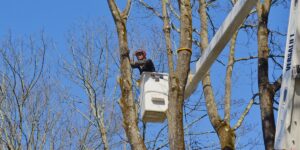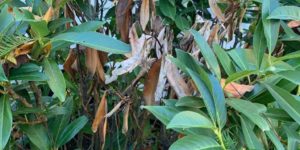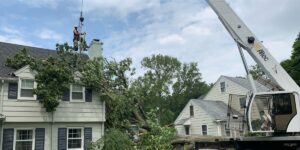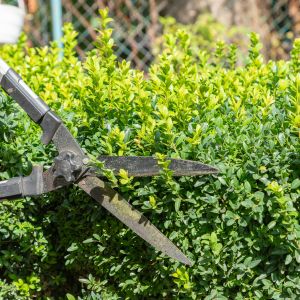Boxwoods are a popular shrub in New Jersey but are at risk from numerous pests. Though many choose boxwoods for their ability to repel deer, they require careful maintenance and observation to spot pest infestations. One of the most common culprits of injuries to these shrubs is boxwood leafminers, also known as Monarthropalpusi flavus.
If left untreated, a boxwood leafminer infestation can lead to damaged shrubs and unpleasant sights in your landscape. You may need to hire a professional to identify an infestation before it becomes a problem and work to treat it and avoid long-term damage.
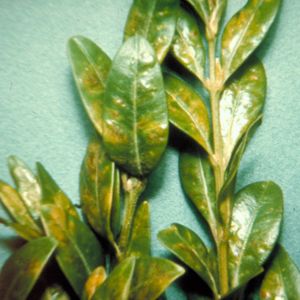
This boxwood has suffered damage from a leafminer, as evidenced by its blistering. (photo by John A. Weidhass, Virginia Polytechnic Institute and State University, Bugwood.org)
Determining if Your Boxwoods Have an Infection
It isn’t always obvious when a boxwood leafminer infection begins, so careful vigilance is crucial to catch an infestation before it causes long-term damage. First, you’ll want to closely monitor your shrubs and pay attention to any orange insects flying around.
The University of Rutgers suggests giving your shrub a gentle tap. If you have an infection, you will likely see numerous boxwood leafminers floating around.
You may also notice blistering and blotches on the leaves of your boxwoods. Upon closer inspection, you’ll find the boxwood leafminer’s eggs inside the leaves.
Listening to your plants can also help with identification, as you may be able to hear the shrubs crackling softly when dealing with an infestation.
Boxwood blight is another issue that can affect your shrubs, though the symptoms differ. For blight, you’ll want to examine the stems for black streaks or check for white sporulation underneath the leaves.
If you’re unsure what’s wrong with your shrubbery, our team at Alpine Tree can examine the issues and give you a full report of the problem and what can be done to save your plant and get it back to full health.
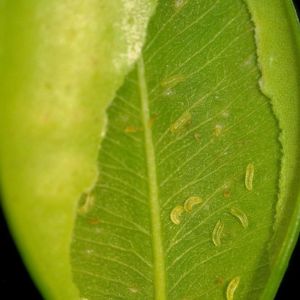
a close up look of a boxwood Leafminer larvae by Brian Kunkel, University of Delaware, Bugwood.org
Boxwood Leafminers: General Information and Habits
Boxwood leafminers typically attack boxwood shrubs and are a common occurrence in New Jersey. The larvae feed and grow within the leaves over the early spring until they become adults and attack the shrub further.
Adults have a short lifespan but will lay eggs in leaves to repeat the process the following year. Unlike some other pests, such as the boxwood mite, leafminers only have one life cycle per year
Seasons When Boxwood Leafminers Pose the Greatest Threat
You should expect to see boxwood leafminers in the spring in New Jersey as they pupate when the weather warms up. Boxwood leafminers enjoy the warm weather, so if our area has a late spring, you may not see the pests until further into May.
Adults will lay their eggs by the end of May or early June. Once the insects lay their eggs, you may notice the characteristic blisters and damage to your plants, though these signs become more apparent as the months go by.
As the eggs hatch into larvae, they will continue feeding on the leaves until next spring, damaging them throughout the year.
Signs You Should Seek Professional Help for a Boxwood Leafminer Infestation
Boxwood leafminer infestations are often not immediately obvious, leading many homeowners to ignore problems as they grow in their yards. If you notice any of the signs of an infestation, such as crackling from your shrubs or blisters on the leaves, you’ll want to contact our team at Alpine Tree to perform a thorough examination and see if your plants need treatment.
While having a professional examine your shrubs and landscape will give you the best information about the health of everything, you should also conduct frequent inspections of your yard to catch any issues before they arise. You’ll want to examine your shrubs at different intervals and seasons to see if anything is changing or if there are any signs of problems.
Best Times to Deal with a Boxwood Leafminer Problem
You’ll want to have a professional treat a boxwood leafminer infestation when you notice adults in flight.
WARNING: Always have a professional handle any pesticide treatment. New Jersey requires private and commercial entities to have certification and licenses to use pesticides.
Timing will vary depending on the weather for a particular year, but we usually recommend seeking treatment in May, as this is typically the time we commonly see boxwood leafminers active in New Jersey. Our team at Alpine Tree can help work with you to create a treatment plan to protect your landscape.
Aside from pesticides, soil injections can help curb the boxwood leafminer population already inside the plant. To protect the plants every season, you’ll want to have a professional tree care service perform this soil injection yearly in the spring.
Fatality in Boxwoods After Leafminer Exposure
Boxwood leafminers likely won’t outright kill your shrubs, but they will cause long-term damage and leave them susceptible to further issues if you don’t take action. You will likely see your boxwood looking worse for wear over the years, and the leaves will become discolored and may begin to defoliate if you have an infestation.
Alternative Treatment Methods for Boxwood Leafminer Infestation
While Boxwoods are prevalent throughout New Jersey, not all shrubs are the same. In fact, there are more than 150 cultivars that we typically call boxwood shrubs. Some of these varieties are very susceptible to boxwood leafminer infestation, while others are quite hardy and will resist damage from the pest.
If you’re planning a row of shrubs, talk to one of our experts at Alpine Tree. We can point you to cultivars that are more resistant and can likely stand up to boxwood leafminer infestations. For instance, cultivars like Buxus sempervirens ‘Buddy’ or Buxus microphylla sinica ‘Franklin’s Gem’ have shown strong resistance to boxwood leafminers.
Regularly pruning your shrubs will also help you prevent boxwood leafminer multiplication. Our team can prune potentially infected leaves to help slow the spread and limit any more damage to your plants.
Alpine Tree Can Assist You with Eradicating an Infestation of Boxwood Leafminers
While Boxwood Leafminers may not be life-threatening to your shrubs, they can lead to long-term damage and issues with your shrubs. It will also leave your beautiful yard looking ragged and unappealing from the curb.
Our team at Alpine Tree is ready to help with any potential problems. We can examine your shrubs, determine if there is an infestation, cure the problem, and perform preventive measures to avoid the problem in the future. Call us at 973-964-7798 or request an estimate online to learn more about how we can help.

